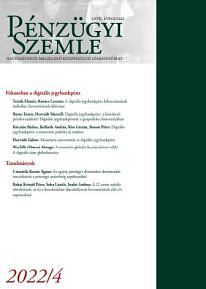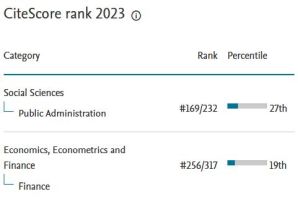A renminbi globális fizetőeszközzé válik? A digitális jüan globalizációja
DOI:
https://doi.org/10.35551/PFQ_2022_4_5Kulcsszavak:
renminbi, nemzetközi monetáris rendszer, tartalékvaluta, amerikai–kínai gazdasági rivalizálás, digitális jüan, F33, F5Absztrakt
A 2008-as globális pénzügyi recesszió és az azt követő, államadóssággal kapcsolatos válság óta az Egyesült Államok gazdasági fölénye gyengült. Kína folyamatosan növekedve pedig megbízható gazdasági erővé vált világszerte, különösen Ázsiában. Vajon tekintettel az amerikai gazdaság pénzügyi uralmának hanyatlására, küszöbön áll-e, hogy a renminbi globális valutává váljon? A jelen kritikai áttekintésben azt állítom, hogy a dollár hegemóniája veszélyben van ugyan, de a politikai és a gazdasági helyzet nem tűnik még érettnek a renminbi globalizációjára. A kínai héják az Ukrajna lerohanása után Oroszországot érintő gazdasági szankciókban esélyt látnak arra, hogy megtörjön az amerikai dollár dominanciája. Továbbá Kína lépéselőnyhöz jutott azáltal, hogy elsőként indította el a digitális jegybankpénzt. Ahhoz azonban, hogy a digitális jüan globalizációja hatékony legyen, Kínának el kell nyernie a külföldi felhasználók bizalmát pénzügyi rendszerének megalapozottsága, gazdasága és a digitális jüan működőképessége iránt. Ezenkívül a renminbi nemzetközivé válásának elősegítése érdekében Kínának enyhítenie kell a tőkeszabályozást, fokoznia kell a renminbi konvertibilitását, és át kell alakítania a pénzügyi rendszerét.
Hivatkozások
Aysan, A. F., Kayani, F. N. (2022). China’s transition to a digital currency does it threaten dollarization? Asia and the Global Economy, 2(1), 100023, https://doi.org/10.1016/j.aglobe.2021.100023
Chandrasekhar, C. P., Ghosh, J. (2020). Bilateral Swaps in China’s Global Presence. Business Line, December 15
Chey, H. K. (2013). Can the renminbi rise as a global currency? The political economy of currency internationalization. Asian Survey, 53(2), pp. 348–368, https://doi.org/10.1525/as.2013.53.2.348
Cohen, B. J. (2012). The benefits and costs of an international currency: getting the calculus right. Open Economies Review, 23(1), pp. 13–31, https://doi.org/10.1007/s11079-011-9216-2
Cohen, B. J. (2017). Renminbi internationalization: a conflict of statecrafts. pp. 1–20. Chatham House
Dongsheng, D. (2020). The Economics and Politics of China’s Currency Internationalization. Global Asia, 15(2), pp. 58–64
Financial Times (2010). Mending Fences in Beijing and Tokyo. Szeptember 14
Greenwald, M. (2020). Digitizing the Dollar in the Age of COVID-19. New Atlanticist, 22
Gu, M. (2020). ‘China’s National Digital Currency DCEP/CBDC Overview’. Online: https://boxmining.com/author/michael/
He, D., McCauley, R. N. (2012). 10 Offshore Markets for the Domestic Currency: Monetary and Financial Stability Issues. The Evolving Role of China in the Global Economy, p. 301, https://doi.org/10.7551/mitpress/9388.003.0017
Helleiner, E. (2008). ‘Below the State: Micro- Level Power’. In: D. Andrews (ed.) International Monetary Power, Ithaca: Cornell University Press
Kazer, W. (2015). China Factory Gauge Slips to Three-Year Low in August. The Wall Street Journal, 1.
Knoerich, J. (2021). China’s new digital currency: Implications for renminbi internationalization and the US Dollar. The (Near) Future of Central Bank Digital Currencies. pp. 145–166
Komlóssy, L., Körmendi, Gy., Ladányi, S. (2017). Út a piacorientált monetáris politika felé és a "New Normal" új monetáris politikai rendszere Kínában. Hitelintézeti Szemle. 16, 101. oldal
Lentner, C. (2016). A gazdasági válság hatása a globális, uniós és hazai szabályozási környezetre – különös tekintettel a felügyeleti elvekre. In Auer, Á. & Papp, T. (ed). A globális gazdasági válság hatása egyes jogintézményekre Magyarországon és az Európai Unióban: interdiszciplináris és összehasonlító elemzés. NKE Szolgáltató Nonprofit Kft: Budapest. 45–84. oldal
Li, A. H. (2015). The tumbled stock market, RMB devaluation, and financial reform in China. China Perspectives, 2015(2015/4), pp. 63–68, https://doi.org/10.4000/chinaperspectives.6870
Lim, E. G. (2006). ‘The Euro’s Challenge to the Dollar’. IMF Working Paper 06/153. McMillan. of International Political Economy, 15(3): pp. 418–438. Press. Reserve Currency Competition’, mimeo, Április, https://doi.org/10.5089/9781451864137.001
Mallaby, S., Wethington, O. (2012). The future of the yuan: China’s struggle to internationalize its currency, Foreign Aff., 91, pp. 135
Mathews, J. A., Selden, M. (2018). China: The emergence of the Petroyuan and the challenge to US dollar hegemony, The Asia-Pacific Journal, 16(22/3), pp. 1–12
Panitch, L., Gindin, S. (2009). Finance and the American empire. In: American empire and the political economy of global finance pp. 17–47. Palgrave Macmillan, London
Patnaik, P. (2015). Devaluation of the Yuan. People›s Democracy, 3(1)
Paulson, H. M. (2020). The future of the dollar. Online: https://www.globalstrikemedia.com/uploads/3/7/7/4/37740703/the_future_of_the_dollar_foreign_affairs.pdf [Hozzáférés: 2021. október 10.]
Póra, A., Széplaki, V. (2022). Kína mint a feltörekvő piacok és fejlődő országok szuverénhitelezője, Pénzügyi Szemle, 67 (2), 196–212. oldal, https://doi.org/10.35551/PFQ_2022_2_3
Riley, C., Yan, S. (2015). China’s stock market crashed in 2 minutes. CNNMoney. Online: http://money.CNN.com/2015/07/09/investing/chinacrash-in-two-minutes.
Rogoff, K. (2021). The US dollar’s hegemony is looking fragile. Guardian, Április 2, London
Siddiqui, K. (2015). Political Economy of Japan’s Decades-Long Economic stagnation. Equilibrium Quarterly Journal of Economics and Economic Policy, 10(4): pp. 9–39, https://doi.org/10.12775/equil.2015.033
Siddiqui, K. (2017). Financialization and Economic Policy: The Issues of Capital Control in the Developing Countries. World Review of Political Economy. 8 (4): pp. 564–589, winter, https://doi.org/10.13169/worlrevipoliecon.8.4.0564
Siddiqui, K. (2019). The US Economy, Global Imbalances and Recent Development: A Critical Review. Istanbul Journal of Economics, 69(2), pp. 175–205, https://doi.org/10.26650/istjecon2019-0027
Siddiqui, K. (2020a). The US Dollar and the World Economy: A critical review. Athens Journal of Economics and Business, 6(1): pp. 21–44. Január, https://doi.org/10.30958/ajbe.6-1-2
Siddiqui, K. (2020b). Can Global Imbalances Continue? The State of the United States Economy”. Argumenta Oeconomica Cracoviensia, 23(2): pp. 11–32, https://doi.org/10.15678/aoc.2020.2301
Siddiqui, K. (2021). The Bilateral Swap Agreements, Chinese Currency, and the Demise of The Us Dollar. World
Simes, D. (2020). China and Russia ditch the dollar in a move towards a ‘financial alliance’. Financial Times, 17
Sitek, P. (2021). Management of Foreign Exchange Reserves of the European Central Bank. Przegląd Prawa i Administracji, 127, pp. 499–512, https://doi.org/10.19195/0137-1134.127.33
Spence, P. (2015). China’s Stock Market Crash: Five Numbers You Need to Know. The Telegraph, 31. Online: https://www.telegraph.co.uk/finance/china-business/11772729/Chinas-stockmarket-crash-five-numbers-you-need-to-know.html
Subacchi, P. (2010). ‚One Currency, Two Systems’: China’s Renminbi Strategy. London: Chatham House.
Subacchi, P. (2016). The people’s money: How China is building a global currency. Columbia University Press
Szilágyi, J. (2018). The Belt and Road Initiative: China’s Grand Strategy to Become a Real Superpower. Dilemmas and Challenges of the Chinese Economy in the 21st Century: Economic Policy Effects of the Belt and Road Initiative, pp. 27–66
Wang, H. (2021). China Meets Digital Currency: E-CNY and Its Implications for Businesses. Law Gazette, Online: https://lawgazette.com.sg/feature/china-meets-digital-currency-e-cny-andits-implications-for-businesses/ [Hozzáférés: 2022. december 6.]
Wei, L., Trivedi, A. (2015). China Boosts Efforts to Keep Money at Home. The Wall Street Journal, 1
Xie, J. (2020). ‘China’s Digital Currency Takes Shape; Will It Challenge Dollar?’. In: Voice of America. 2020. április 25, Online: https://www.voanews.com/economy-business/Chinas-digitalcurrency- takes-shape-will-it-challenge-dollar
Yao, S., Luo, D. (2008). Chinese stock market bubble: inevitable or incidental? The University of Nottingham
Zhang, B., Wang, S., Wei, Y., Zhao, X. (2021). Impact of the RMB Joining the SDR Basket on Its Internationalization from the Perspective of Risk Spillover. Journal of Systems Science and Complexity, 34(1), pp. 339–350, https://doi.org/10.1007/s11424-020-9215-8
Zhou, C. (2020). ‘China’s Digital Currency Edges Closer with Large-Scale Test by Four State-Owned Banks’. South China Morning Post, 2020. augusztus 6.
IMF (2020). World Economic and Financial Surveys. Online: https://www.imf.org/en/Publications/WEO/weo-database/2021/April/weoreport?c=924,111,&s=NGDP_RPCH,NGDPD,PPPGDP,NGDPDPC,PPPPC,&sy=2020&ey=20 26&ssm=0&scsm=0&scc=0&ssd=1&ssc=0&sic= 0&sort=country&ds=.&br=1 [Hozzáférés: 2022. november 23.]
IMF (2021). US Dollar share of global foreign exchange reserve drops to a 25-year low. Online: https://blogs.imf.org/2021/05/05/us-dollar-shareof-global-foreign-exchange-reserves-drops-to-25-year-low/ [Hozzáférés: 2022. november 23.]
IMF (2022). Currency Composition of Foreign Exchange-(COFER). Online: https://data.imf.org/?sk=E6A5F467-C14B-4AA8-9F6D-5A09EC4E62A4 [Hozzáférés: 2022. november 17.]
Newsweek. (2021). “Will the US Dollar Lose Its Place as the World’s No. 1 Reserve Currency?”, New York. Online: https://www.newsweek.com/will-us-dollar-lose-its-place-worlds-no-1-reservecurrency-1567224 .[Hozzáférés: 2022. május 19.]
People’s Bank of China, (PBOC, 2021). RMB Internalization Report. Online: http://www.pbc.gov.cn/en/3688110/3688172/4157443/4433239/2021122809344466286.pdf
##submission.downloads##
Megjelent
Hogyan kell idézni
Folyóirat szám
Rovat
License
Authors assign copyright to Pénzügyi Szemle / Public Finance Quarterly. Authors are responsible for permission to reproduce copyright material from other sources.












